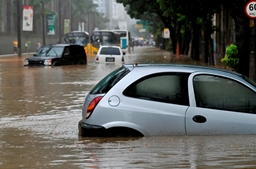Floods are among the most frequent and costly natural disasters in the United States. The effects can be local, hampering neighborhoods and communities, or widespread causing damage to entire river basins that may affect multiple states.
How to Prepare for Flooding
-
Standard homeowners insurance doesn't cover flooding. Take flood insurance into consideration to protect your home and possessions.
-
Take an inventory of all household goods making sure to document model numbers, brand names, ages, purchase prices, and places of purchase. Place the information in a waterproof container or safe deposit box.
-
Clear debris from gutters and downspouts for smooth water flow away from your house and place furniture and appliances on risers above your home’s projected flood elevation.
-
Create an emergency kit that has enough supplies for three to seven days, including one gallon of water daily per person, non-perishable food, handheld can opener, paper plates and plastic utensils, blankets and pillows, rain gear, a First-Aid kit, medications and prescriptions, toiletries and battery operated radios and flashlights with spare batteries. Make sure your cell phone is fully charged.
During a Flood
-
Comply with all evacuation instructions.
-
According to the National Weather Service just one foot of flowing water is powerful enough to sweep vehicles off the road. Do not attempt to walk or drive through flooded roadways.
-
Monitor flood advisories on the radio, television or the National Oceanic & Atmospheric Administration website.
-
If you are in a vehicle and water is rising, exit the vehicle quickly and move to higher ground. If in your home or office, prepare to evacuate or move to the highest level of the building or the roof.
After a Flood
-
Make sure your community’s water is safe to drink after a flood.
-
Avoid local water sources such as rivers and streams and puddled floodwater as it may be contaminated with oil, gas or sewage.
-
Use caution when returning to your home or office. Foundations and walls may have been weakened due to water damage.
-
Clean and disinfect anything the flood waters touched. Discard unsalvageable items as soon as possible to prevent the spread of bacteria.
-
If power lines are down, do not touch or stand in water near them.




















